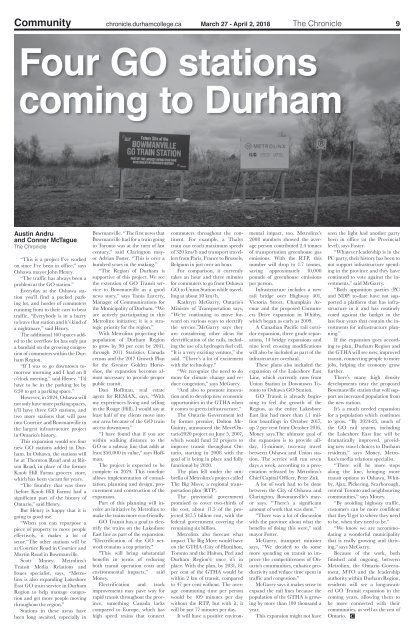You also want an ePaper? Increase the reach of your titles
YUMPU automatically turns print PDFs into web optimized ePapers that Google loves.
Community chronicle.durhamcollege.ca March 27 - April 2, 20<strong>18</strong> The <strong>Chronicle</strong> 9<br />
Four GO stations<br />
coming to Durham<br />
Austin Andru<br />
and Conner McTague<br />
The <strong>Chronicle</strong><br />
“This is a project I’ve worked<br />
on since I’ve been in office,” says<br />
Oshawa mayor John Henry.<br />
“The traffic has always been a<br />
problem at the GO station.”<br />
Everyday at the Oshawa station<br />
you’ll find a packed parking<br />
lot, and hordes of commuters<br />
running from to their cars to beat<br />
traffic. “Everybody is in a hurry<br />
to leave that station and it’s kind of<br />
a nightmare,” said Henry.<br />
The additional 160 spaces added<br />
to the overflow lot has only put<br />
a bandaid on the growing congestion<br />
of commuters within the Durham<br />
Region.<br />
“If I was to go downtown tomorrow<br />
morning and I had an 8<br />
o’clock meeting,” said Henry. “I’d<br />
have to be in the parking lot by<br />
6:30 to get a parking space.”<br />
However, in 2024, Oshawa will<br />
not only have more parking spaces,<br />
it’ll have three GO stations, and<br />
two more stations that will pass<br />
into Courtice and Bowmanville in<br />
the largest infrastructure project<br />
in Ontario’s history.<br />
This expansion would see four<br />
new GO stations added in Durham.<br />
In Oshawa, the stations will<br />
be at Thornton Road and at Ritson<br />
Road, in place of the former<br />
Knob Hill Farms grocery store,<br />
which has been vacant for years.<br />
“The foundry that was there<br />
(before Knob Hill Farms) had a<br />
significant part of the history of<br />
Ontario,” said Henry.<br />
But Henry is happy that it is<br />
going to good use.<br />
“When you can repurpose a<br />
piece of property to move people<br />
effectively, it makes a lot of<br />
sense.”The other stations will be<br />
at Courtice Road in Courtice and<br />
Martin Road in Bowmanville.<br />
Scott Money, Metrolinx’s<br />
Transit Media Relations and<br />
<strong>Issue</strong>s specialist, says, “Metrolinx<br />
is also expanding Lakeshore<br />
East GO train service in Durham<br />
Region to help manage congestion<br />
and get more people moving<br />
throughout the region.”<br />
Stations in these areas have<br />
been long awaited, especially in<br />
Bowmanville. “The first news that<br />
Bowmanville had for a train going<br />
to Toronto was at the turn of last<br />
century,” said Clarington mayor<br />
Adrian Foster. “This is over a<br />
hundred years in the making.”<br />
“The Region of Durham is<br />
supportive of this project. We see<br />
the extension of GO Transit service<br />
to Bowmanville as a good<br />
news story,” says Tania Laverty,<br />
Manager of Communications for<br />
the Municipality of Durham. “We<br />
are actively participating in this<br />
Metrolinx initiative; it is a strategic<br />
priority for the region.”<br />
With Metrolinx projecting the<br />
population of Durham Region<br />
to grow by 90 per cent by 2041,<br />
through 2011 Statistics Canada<br />
census and the 20<strong>17</strong> Growth Plan<br />
for the Greater Golden Horseshoe,<br />
the expansion becomes almost<br />
necessary to provide proper<br />
public transit.<br />
Dan Hoffman, real estate<br />
agent for REMAX, says, “With<br />
my experiences living and selling<br />
in the Rouge (Hill). I would say at<br />
least half of my clients move into<br />
our area because of the GO train<br />
access downtown.”<br />
“I have found that if you are<br />
within walking distance to the<br />
GO or a subway line that adds at<br />
least $50,000 in value,” says Hoffman.<br />
The project is expected to be<br />
complete in 2024. This timeline<br />
allows implementation of consultation,<br />
planning and design, procurement<br />
and construction of the<br />
expansion.<br />
Part of this planning will involve<br />
an initiative by Metrolinx to<br />
make the trains more eco-friendly.<br />
GO Transit has a goal to electrify<br />
the trains on the Lakeshore<br />
East line as part of the expansion.<br />
“Electrification of the GO network<br />
remains a top priority."<br />
"This will bring substantial<br />
benefits in terms of reducing<br />
both transit operation costs and<br />
environmental impacts,” said<br />
Money.<br />
Electrification and track<br />
improvements may pave way for<br />
rapid transit throughout the province,<br />
something Canada lacks<br />
compared to Europe, which has<br />
high speed trains that connect<br />
commuters throughout the continent.<br />
For example, a Thalys<br />
train can reach maximum speeds<br />
of 320 km/h and transport travellers<br />
from Paris, France to Brussels,<br />
Belgium in just over an hour.<br />
For comparison, it currently<br />
takes an hour and three minutes<br />
for commuters to go from Oshawa<br />
GO to Union Station while travelling<br />
at about 50 km/h.<br />
Kathryn McGarry, Ontario’s<br />
Minister of Transportation says,<br />
“We’re continuing to move forward<br />
on various ways to electrify<br />
the service.”McGarry says they<br />
are considering other ideas for<br />
electrification of the rails, including<br />
the use of a hydrogen fuel cell.<br />
“It is a very exciting venture,” she<br />
said. “There’s a lot of excitement<br />
with the technology.”<br />
“We recognize the need to do<br />
more for climate change and reduce<br />
congestion,” says McGarry.<br />
“And also to promote innovation<br />
and to develop new economic<br />
opportunities in the GTHA when<br />
it comes to green infrastructure.”<br />
The Ontario Government led<br />
by former premier, Dalton Mc-<br />
Guinty, announced the MoveOntario2020<br />
project on June 5, 2007,<br />
which would fund 52 projects to<br />
improve transit throughout Ontario,<br />
starting in 2008 with the<br />
goal of it being in place and fully<br />
functional by 2020.<br />
The plan fell under the umbrella<br />
of Metrolinx’s project called<br />
The Big Move, a regional transportation<br />
plan (RTP).<br />
The provincial government<br />
promised to cover two-thirds of<br />
the cost, about 11.5 of the projected<br />
$<strong>17</strong>.5 billion cost, with the<br />
federal government covering the<br />
remaining six billion.<br />
Metrolinx also forecast what<br />
impact The Big Move would have<br />
on the GTHA (City of Hamilton,<br />
Toronto and the Halton, Peel and<br />
Durham Region’s) once it’s in<br />
place. With the plan, by 2031, 81<br />
per cent of the GTHA would be<br />
within 2 km of transit, compared<br />
to 47 per cent without. The average<br />
commuting time per person<br />
would be <strong>10</strong>9 minutes per day<br />
without the RTP, but with it, it<br />
will be just 77 minutes per day.<br />
It will have a positive environmental<br />
impact, too. Metrolinx’s<br />
2008 numbers showed the average<br />
person contributed 2.4 tonnes<br />
of transportation greenhouse gas<br />
emissions. With the RTP, this<br />
number will drop to 1.7 tonnes,<br />
saving approximately <strong>10</strong>,000<br />
pounds of greenhouse emissions<br />
per person.<br />
Infrastructure includes a new<br />
rail bridge over Highway 401,<br />
Victoria Street, Champlain Avenue<br />
and the proposed Consumers<br />
Drive expansion in Whitby,<br />
which began as early as 2009.<br />
A Canadian Pacific rail corridor<br />
expansion, three grade separations,<br />
14 bridge expansions and<br />
nine level crossing modifications<br />
will also be included as part of the<br />
infrastructure overhaul.<br />
These plans also included the<br />
expansion of the Lakeshore East<br />
Line, which currently runs from<br />
Union Station in Downtown Toronto<br />
to Oshawa GO Station.<br />
GO Transit is already beginning<br />
to feel the growth of the<br />
Region, as the entire Lakeshore<br />
East line had more than 1.1 million<br />
boardings in October 20<strong>17</strong>,<br />
up 2 per cent from October 2016,<br />
Money says.The ultimate goal of<br />
the expansion is to provide allday,<br />
15-minute, two-way travel<br />
between Oshawa and Union station.<br />
The service will run seven<br />
days a week, according to a presentation<br />
released by Metrolinx’s<br />
Chief Capital Officer, Peter Zuk.<br />
A lot of work had to be done<br />
between the City of Oshawa and<br />
Clarington, Bowmanville’s mayor<br />
says. “There’s a significant<br />
amount of work that was done.”<br />
“There was a lot of discussion<br />
with the province about what the<br />
benefits of doing this were,” said<br />
mayor Foster.<br />
McGarry, transport minister<br />
says, “We decided to do some<br />
more spending on transit to improve<br />
the competitiveness of Ontario’s<br />
communities, enhance productivity<br />
and reduce time spent in<br />
traffic and congestion.”<br />
McGarry says it makes sense to<br />
expand the rail lines because the<br />
population of the GTHA is growing<br />
by more than <strong>10</strong>0 thousand a<br />
year.<br />
This expansion might not have<br />
seen the light had another party<br />
been in office (at the Provincial<br />
level), says Foster.<br />
“Whatever leadership is in the<br />
PC party, their history has been to<br />
not support infrastructure spending<br />
in the province and they have<br />
continued to vote against the investments,”<br />
said McGarry.<br />
“Both opposition parties (PC<br />
and NDP) to-date have not supported<br />
a platform that has infrastructure<br />
in it and has routinely<br />
voted against the budget in the<br />
last four years that contain the investments<br />
for infrastructure planning.”<br />
If the expansion goes according<br />
to plan, Durham Region and<br />
the GTHA will see new, improved<br />
transit, connecting people to more<br />
jobs, helping the economy grow<br />
further.<br />
There’s many high density<br />
developments near the proposed<br />
Bowmanville station that will support<br />
an increased population from<br />
the new station.<br />
It’s a much needed expansion<br />
for a population which continues<br />
to grow. “By 2024-25, much of<br />
the GO rail system, including<br />
the Lakeshore East line will be<br />
dramatically improved, providing<br />
new travel choices to Durham<br />
residents,” says Money, Metrolinx’s<br />
media relations specialist.<br />
“There will be more stops<br />
along the line, bringing more<br />
transit options to Oshawa, Whitby,<br />
Ajax, Pickering, Scarborough,<br />
central Toronto and neighbouring<br />
communities,” says Money.<br />
“By avoiding highway traffic,<br />
customers can be more confident<br />
that they’ll get to where they need<br />
to be, when they need to be.”<br />
“We know we are accommodating<br />
a wonderful municipality<br />
that is really growing and thriving,”<br />
says McGarry.<br />
Because of the work, both<br />
finished and ongoing, between<br />
Metrolinx, the Ontario Government,<br />
MTO and the leadership<br />
authority within Durham Region,<br />
residents will see a long-awaited<br />
GO Transit expansion in the<br />
coming years, allowing them to<br />
be more connected with their<br />
communities, as well as the rest of<br />
Ontario.


















